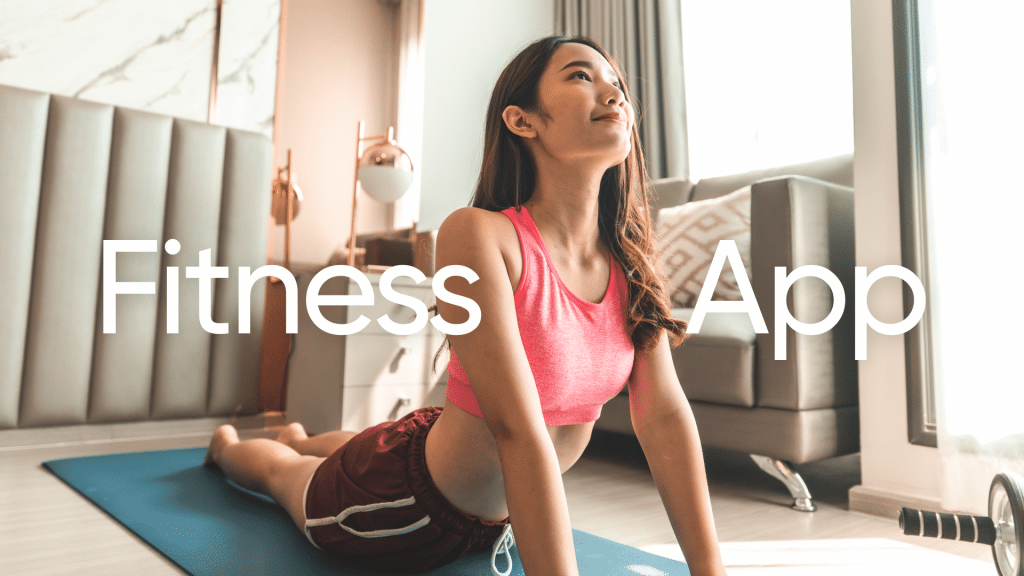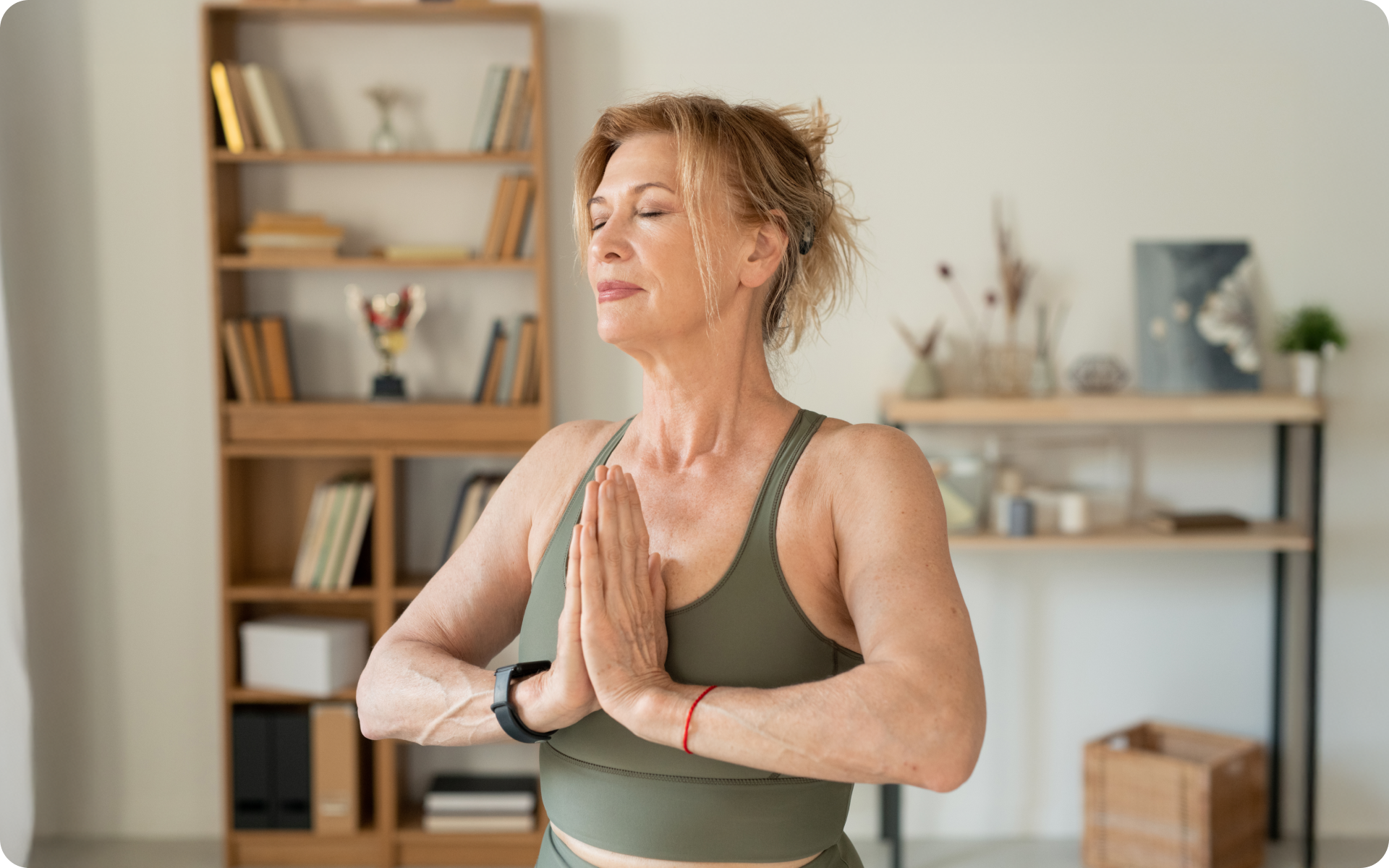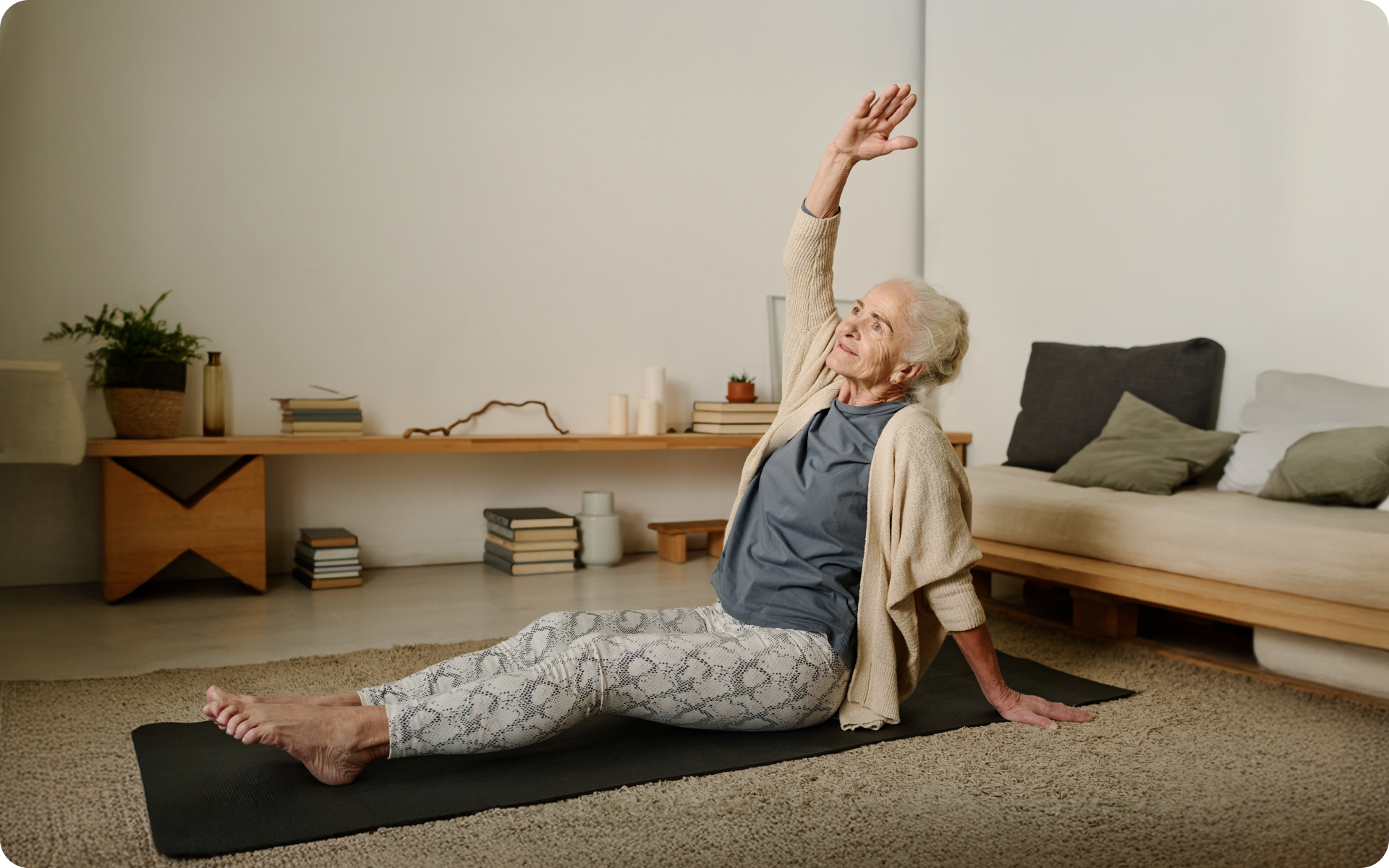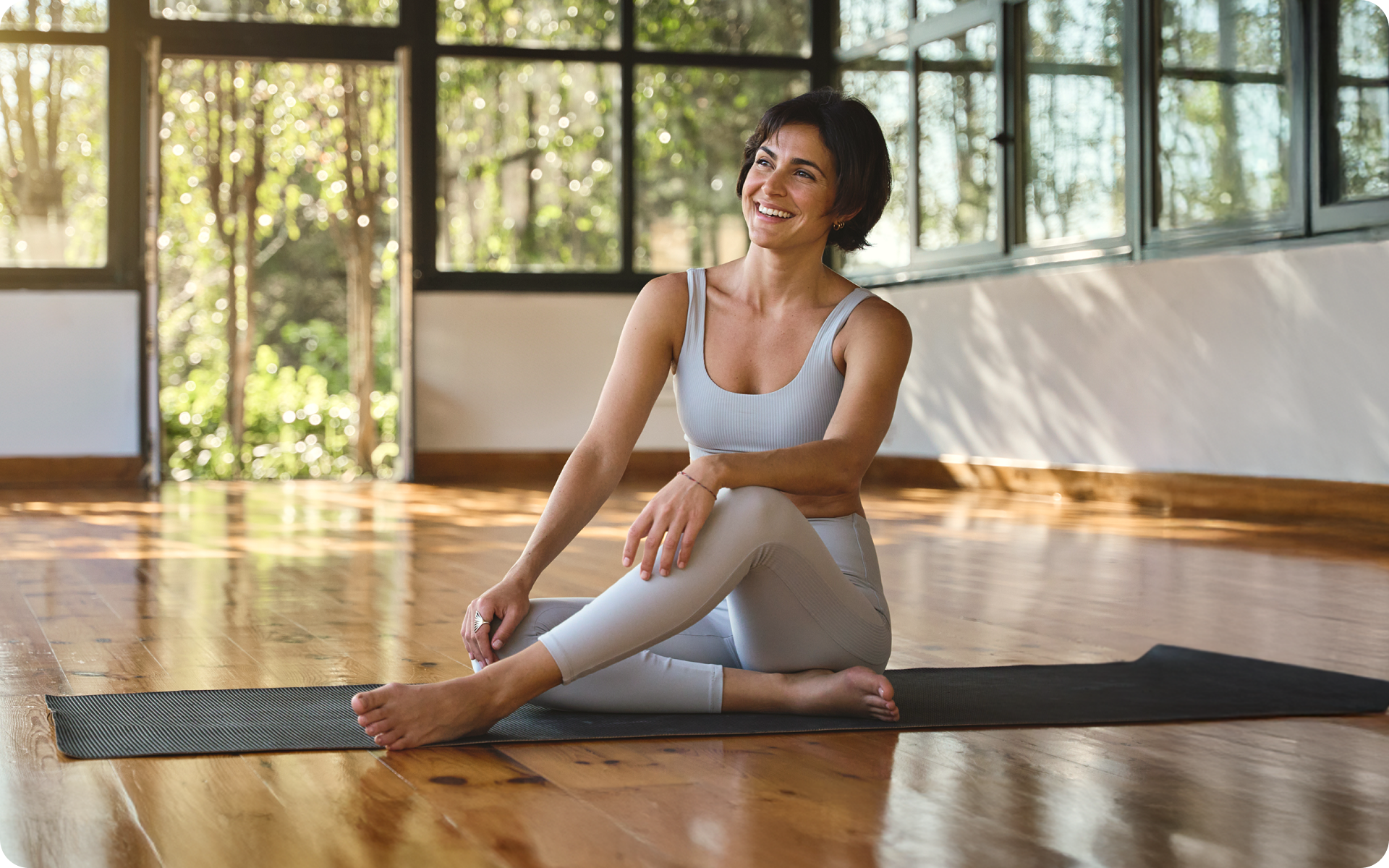Getting stressed over the course of your day seems inevitable—you’re either juggling too many tasks, feeling overwhelmed at work, or dealing with a difficult situation. While eliminating stressors is not always possible, managing your stress levels is. And of all the ways (think meditating, exercising, or even journaling) of doing so, stretching can be one of the most convenient and effective. From a scientific standpoint, stretching helps relieve stress by releasing endorphins, which are natural painkillers (4). It also gives you a much-welcome break from the chaos of your day, allowing you to take a step back and focus on yourself.
Get your personalized
meal plan!
Here are 9 easy yet effective stretches that you can do anywhere, anytime, to help manage your stress levels:
1. Seated Neck Release
The neck area is particularly vulnerable to tension, especially when you’re hunched over for long periods of time. Research shows that stress can actually trigger a persistent, unrelenting pain in this area, and if left untreated it may manifest as a tension headache (3).
To help ease the tension in your neck, perform this seated stretching exercise:
- Sit tall in a chair with your feet flat on the floor
- With your shoulders relaxed, slowly tilt your head to one side until you feel a stretch
- Hold for 10 seconds, then tilt your head to the other side and hold for another 10 seconds
- Repeat this stretch a few times
- Next, tilt your head back and hold for 10 seconds, then lower it until your chin touches your chest and hold for another 10
- Repeat this stretch a few times.
2. Shoulder Roll
This exercise is great for releasing tightness in the upper back and shoulders, which we tend to clench when we’re feeling stressed or anxious. Anyone who works a desk job or spends a lot of time in front of the computer can benefit from this stretch!
- Sit tall with your feet flat on the floor and your hands resting in your lap
- Lift both of your shoulders up towards your ears as you roll them backward
- Roll them in a circular motion, forwards and backward at least 6 times
- Relax your shoulders and enjoy the sensation of release afterward.
3. Standing Chest Expansion
This stretch is great for opening up your chest and releasing tension in the back. It’s also a great way to improve your posture, which, over time, can help you manage your stress levels better.
- Stand tall with your feet shoulder-width apart
- Take a deep breath and lift your arms up and back, feeling the stretch in your chest
- Hold this position for 10 seconds, then slowly lower your arms
- Repeat this stretch a few times.
Read More: Beginner Hip Flexor Stretch: Loosen Tight Hips With A Few Easy Moves
4. Quad Stretch
The quadriceps are muscles on the front of your thighs that can become tense not only from physical exercise but also from long periods of sitting. Because stress can also cause muscular tension (3), this stretch is an effective way to release it.
- Stand tall with your feet shoulder-width apart
- Gently grab your right foot with your right hand and pull it toward your buttocks
- Hold the stretch for 10-15 seconds
- Release your foot and repeat the same stretch with your left leg
- Repeat this stretch a few times.
5. Child’s Pose
A restorative yoga posture, Child’s Pose is an incredibly calming and relaxing stretch that helps to ease tension in the back and neck (2). This stretch can also help you to relax and refocus your thoughts, allowing you to better manage any stress or anxiety you may be feeling. Roll your mat out in the park on your lunch break and try this stretch:
- Kneel on your mat with your feet together and your knees hip-width apart
- Sit back onto your heels and lower your torso until it is between your thighs
- Extend your arms out in front of you
- Take deep, calming breaths and hold the pose for 10-15 seconds
- Release the pose and repeat a few times.
6. Seated Cat/Cow
This stretch is designed to help release tension in the spine and back. It’s known as a ‘cat/cow’ stretch because of the way you move your spine like a cat arching its back and then curving it like a cow. Traditionally done on all fours, this seated version is an easy and effective way to release tension (1).
Sit tall in a chair with your feet flat on the floor. Place your hands on your thighs.
- Take a deep breath, arch your back, jutting your chest forward and lifting your chin
- Hold this position for a few seconds, then exhale and round your spine, tucking your chin and drawing your navel towards your spine
- Repeat this stretch a few times.
If you can, here’s how to perform the traditional cat/cow stretch:
- Get on all fours, with your wrists under your shoulders and your knees under your hips
- Inhale and arch your back, lifting your chest and tailbone
- Exhale and round your spine, tucking your chin and drawing your navel towards your spine
- Repeat this stretch a few times.
Dropping pounds by the dozens without putting yourself through the wringer is everyone’s weight loss pipe dream. But what if we told you that the BetterMe app can make that happen? Keep yourself in prime shape with our fat-blasting workouts, delicious budget-sparing recipes, and body-transforming challenges with our app!
7. Happy Baby Pose
This fun-sounding stretch is an effective way to release tension in the lower back, hips, and thighs. It also helps you relax, making it ideal for managing stress. You’ll need a yoga mat for this one:
- Lie on your back and draw your knees into your chest
- Grab the outside edges of your feet with your hands and draw them in towards the body
- Gently press down on your knees with your arms, feeling a release in the lower back
- Hold this pose for 10-15 seconds and then release your feet
- Repeat this stretch a few times
- Take a few deep breaths and relax into the pose.
8. Forward Fold
The forward fold stretch is a great way to release tension in the back, neck and shoulders. It’s also an effective calming exercise that can help you relax and refocus your mind.
- Stand tall with your feet shoulder-width apart and fold forward at the hips
- Let your arms hang down and allow your torso to relax
- Hold this position for 10-15 seconds and then release
- Repeat this stretch a few times
- When you’re finished, roll up slowly and take a few deep breaths.
9. Seated Spinal Twist
The seated spinal twist is a great way to release tension in the back, neck and shoulders. It also helps you relax and refocus your mind – perfect for managing stress.
- Sit cross-legged on your mat with your spine tall and your shoulders relaxed. A chair can also be used as an alternative if you’re at work
- Place your right hand on your left knee and twist your torso to the left
- Hold this position for 10-15 seconds, then switch sides
- Repeat this stretch a few times, taking a few deep breaths with each twist
- When you’re finished, take a few more deep breaths and relax into the posture.
Read More: Sofa Yoga: The Lazy Girls And Guys’ Guide To Stretching
How Long Should You Stretch For Stress Relief?
If you’re yet to commit to a regular stretching routine because you’re super busy or even way too tired to think about it, you’ll be happy to hear that you can still reap the stress-relieving benefits of stretching in just 5-10 minutes.
Whether you’re feeling overwhelmed at work or anxious about an upcoming exam, taking a few minutes out of your day to consciously stretch can help you relax and release any built up tension.
A good sequence of stretching exercises should involve both dynamic and static stretches. Dynamic stretches involve actively moving your body into the stretch, whereas static stretches require you to hold a position for a period of time.
How much time you spend on each stretch depends entirely on you and your body. Some of us may find 10 seconds is enough for one stretch, others can go for longer. Listen to your body and take breaks if necessary.
Other tips to follow for successfully managing stress with stretching include:
- Focus on breathing during each stretch, this will help you to relax
- Choose stretches that are tailored to the areas where you’re feeling tension
- Use positive self-talk and focus on releasing any negative energy in your body
- Find a quiet space or go outside and savor the fresh air to really reconnect with your body
- Focus on how you’re feeling during each stretch and use this as a mindful exercise
- Reward yourself after each session with something relaxing, such as a cup of herbal tea or a warm bath.
Want to build an attention-grabbing bubble butt, blast away fat that’s stored in all the wrong places, spring-clean your diet, turn back the clock on your skin, skyrocket your self-confidence and shatter your insecurities? Check out the BetterMe app and set this plan in motion!
The Bottom Line
Stretching is a great way to manage stress and give your body some love. Take the time to tune into your body and really focus on your breathing. This will help you to relax and let go of any built up tension. With regular practice, you can enjoy long-term stress relief and better overall wellbeing.
DISCLAIMER:
This article is intended for general informational purposes only and does not serve to address individual circumstances. It is not a substitute for professional advice or help and should not be relied on for making any kind of decision-making. Any action taken as a direct or indirect result of the information in this article is entirely at your own risk and is your sole responsibility.
BetterMe, its content staff, and its medical advisors accept no responsibility for inaccuracies, errors, misstatements, inconsistencies, or omissions and specifically disclaim any liability, loss or risk, personal, professional or otherwise, which may be incurred as a consequence, directly or indirectly, of the use and/or application of any content.
You should always seek the advice of your physician or other qualified health provider with any questions you may have regarding a medical condition or your specific situation. Never disregard professional medical advice or delay seeking it because of BetterMe content. If you suspect or think you may have a medical emergency, call your doctor.
SOURCES:
- Stress management (2021, mayoclinic.org)
- Stress management (2021, nih.gov)
- Stress biomarkers’ associations to pain in the neck, shoulder and back in healthy media workers: 12-month prospective follow-up (2008, nih.gov)
- Understanding Endorphins and Their Importance in Pain Management (2010, nih.gov)










